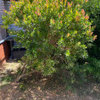Hi,
I am growing Nothofagus moorei at two properties with two different soil conditions, and I have a problem that is stumping me.
In sand but deep shade with high summer heat, the tree seems to be doing well.
In clay, but planted on a hill in an elevated mound and with an artificial drain to minimize flooding the roots too much, the tree is gradually declining. There is a trick that has worked well with my other Nothofagus plants (supplementing them with abundant potassium), that keeps them from doing the same thing, but for some reason, my N. moorei just doesn't seem to respond to potassium like the other Nothofagus plants do.
The symptoms are classic Potassium shortage: Older leaves show scorching on the outer edges of the leaves, with loss of chlorophyll also on the outer edges, working their way inward. Eventually the older leaves fall. The newer growth lacks the healthy pink tones of new growth in that species, tends to be small and deformed, and ultimately aborts.
Are there any specific nutritional requirements for this species I should know about?
Thanks!





conifer_nut
nathanhurst
Davedel
goted
nathanhurst
ribman
nathanhurst